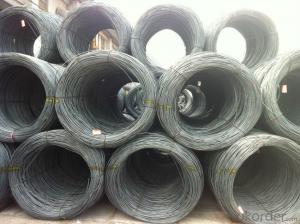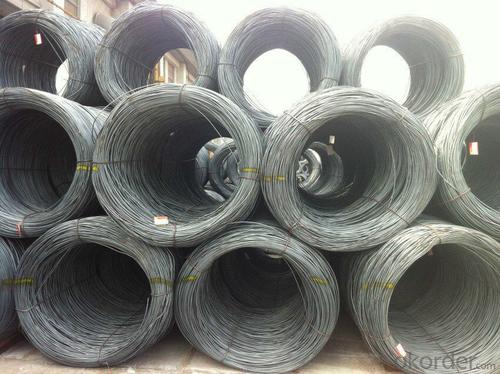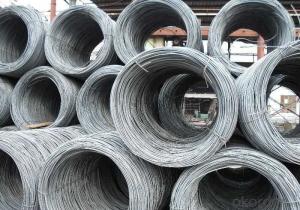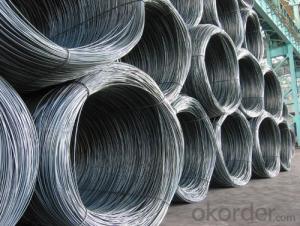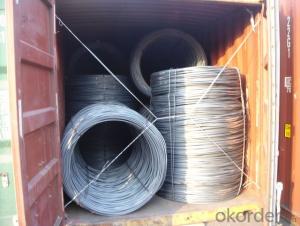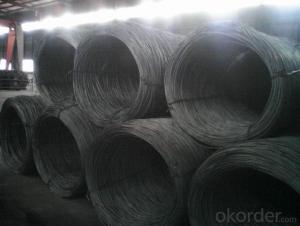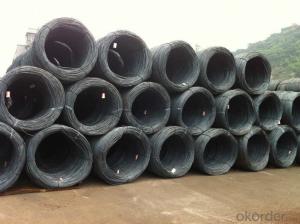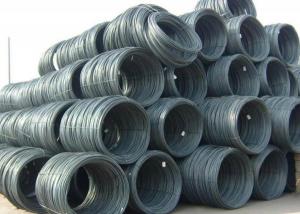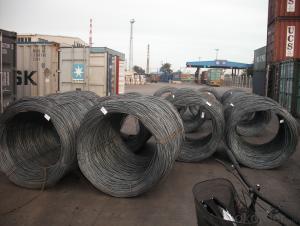Supply 6.5mm steel wire rod in coils in sale
- Loading Port:
- Tianjin
- Payment Terms:
- TT OR LC
- Min Order Qty:
- 25 m.t.
- Supply Capability:
- 500000 m.t./month
OKorder Service Pledge
OKorder Financial Service
You Might Also Like
Specification
Steel Grade: Q195/235, SAE1006-1018B Standard: ASTM, GB
Diameter: 5.5mm, 6.5mm, 7mm,8mm,9mm,10mm,12mm,14mm
Type: Drawn Wire Alloy or Not: Alloy Brand Name: HSKY
Technique: Hot Rolled Place of Origin: China Mainland
Chemical Composition:(Please kindly find our chemistry of our material based on SAE1006B and SAE1008B as below for your information)
High carbon/Low carbon/common carbon Steel wire rod | With boron for rebate tax |
Grade | SAE1006B SAE1008B SAE1018B |
Package | In coil ,in bundle, |
Coil weight | about 2000kg-3000kgs |
Size: | 5.5mm 6.5mm 8mm 10mm 12mm 14mm 16mm |
Types | High Carbon ,Low carbon ,Common carbon |
Exported Country | South Korea,Vietnam,Indonesia,Myanmar,Philippines and Afrca,Ect |
Delivery term: | within 30 days after receive the LC |
Payment Term: | LC at sight ,LC 30-120 days after B/L date, TT payment |
The Standard of Physical Properties:
Grade | Chemical Composition(%) | |||||
C | Mn | Si | S | P | Cr | |
SAE1006 | 0.03~O.07 | ≤0.32 | ≤0.30 | ≤0.045 | ≤0.040 | >0.30 |
Mechanical properties | ||||||
Yield strength(N/mm2) | Tensile strength(N/mm2) | Elongation(%) | ||||
250-280 | 350-380 | ≥32 | ||||
Grade | Chemical Composition(%) | |||||
C | Mn | Si | S | P | Cr | |
SAE1008 | 0.10max | 0.3~O.50 | 0.15max | 0.050max | 0.040 max | 0.30 min |
Mechanical properties | ||||||
Yield strength(N/mm2) | Tensile strength(N/mm2) | Elongation(%) | ||||
≥195 | 315-430 | ≥30 | ||||
Usage and Applications of Steel Wire Rod in Coil:
After hot-rolled the products shaped into coil and delivery as finished product, including round, square, rectangular, hexagonal and so on, Since most of the products are round, it is generally called wire rod. Steel wire rod is widely used in construction and manufacturing. Steel wire rod is mainly used for reinforcement of reinforced concrete and welded structure or reprocessed (roberts, nail etc) materials, especially used to produce wire drawing, welding electrode, nails,spring, electronic, precise machinery parts and so on.
Packaging & Delivery of Steel Wire Rod in Coil:
Packaging Detail: products are packed in coil and then shipped by container or bulk vessel
Each coil weight: 2-3MT
Delivery Detail: within 45 days after received deposit or LC.
Label: to be specified by customer, generally, each bundle has 1-2 labels
Trade terms: CFR, CIF
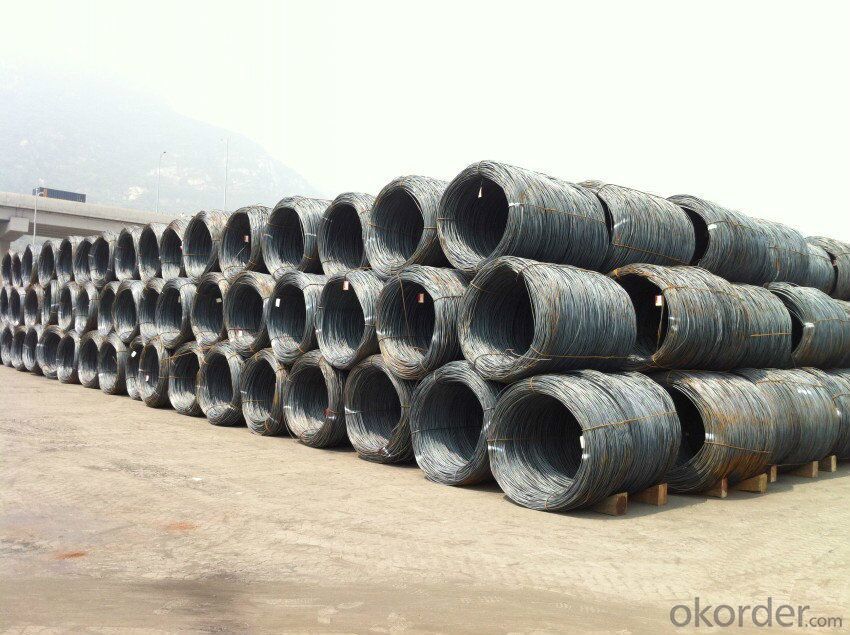
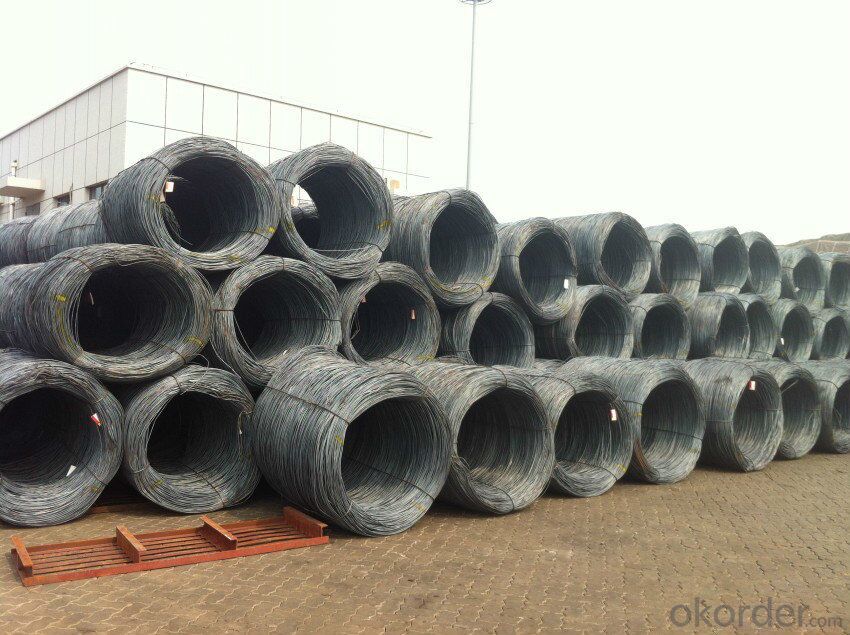
- Q: What are the common standards and certifications for steel wire rod?
- Steel wire rod must adhere to various standards and certifications to ensure its quality and compliance with industry regulations. Some widely recognized ones include: 1. ASTM International Standards: Commonly used for steel wire rod are ASTM A510 and ASTM A853. These standards outline the necessary requirements for carbon steel wire rods used in various applications, such as wire product manufacturing, nail production, and fencing. 2. ISO Certification: ISO 9001 is a well-known quality management system standard that guarantees consistent quality and customer satisfaction. Many steel wire rod manufacturers obtain ISO 9001 certification, indicating their commitment to rigorous quality control processes. 3. European Standards (EN): EN 10016-2 is a standard specifically applicable to wire rod manufactured and used within the European Union. It specifies the technical delivery conditions for non-alloy steel wire rod used for general purposes. 4. American Petroleum Institute (API) Certification: API Spec 5L is a certification specifically relevant to steel wire rod used in the oil and gas industry. This certification ensures that the wire rod meets the necessary requirements for use in pipelines and related applications. 5. International Electrotechnical Commission (IEC) Standards: IEC 60949 is a standard that specifies the requirements for copper or aluminum wire rod used in electrical purposes. Although not specifically for steel wire rod, the electrical industry follows IEC standards to ensure safety and performance. It is crucial to note that different applications may have specific requirements, and manufacturers often comply with additional industry-specific certifications or customer-specific standards. These certifications and standards are vital in maintaining consistent quality, safety, and performance of steel wire rod in various industries.
- Q: What are the factors that influence the mechanical properties of steel wire rod?
- There are several factors that can influence the mechanical properties of steel wire rods. These factors include: 1. Composition: The chemical composition of the steel, including the presence of alloying elements, plays a significant role in determining its mechanical properties. Elements such as carbon, manganese, silicon, and others can affect the strength, hardness, and ductility of the wire rod. 2. Microstructure: The microstructure of the steel, which is determined by factors such as cooling rate and heat treatment, can greatly influence its mechanical properties. The arrangement of grains, the presence of impurities, and the size and distribution of precipitates can all affect the wire rod's strength, toughness, and other properties. 3. Processing conditions: The processing conditions during the production of wire rods, such as the temperature, cooling rate, and rolling conditions, can have a significant impact on the mechanical properties. For example, controlled cooling rates can result in a fine-grained microstructure, which can enhance the wire rod's strength and toughness. 4. Heat treatment: Heat treatment processes such as annealing, quenching, and tempering can be used to further modify the mechanical properties of steel wire rods. These processes can help to refine the microstructure, relieve internal stresses, and improve the wire rod's strength, hardness, and ductility. 5. Surface finish: The surface finish of the wire rod, including factors such as scale, decarburization, and surface defects, can also affect its mechanical properties. A smooth and clean surface can contribute to better fatigue resistance and overall mechanical performance. 6. Size and shape: The size and shape of the wire rod, including its diameter and cross-sectional profile, can influence its mechanical properties. Thicker rods tend to have higher strength but lower ductility, while thinner rods may exhibit higher ductility but lower strength. 7. Environmental conditions: The mechanical properties of steel wire rods can also be influenced by the environmental conditions in which they are used. Factors such as temperature, humidity, and exposure to corrosive substances can all impact the wire rod's strength, toughness, and corrosion resistance. It is important to consider these factors when selecting or designing steel wire rods for specific applications, as they can greatly impact the performance and reliability of the final product.
- Q: What are the different surface finishes available for steel wire rod?
- There are several different surface finishes available for steel wire rod, including hot-rolled, pickled and oiled, cold-drawn, galvanized, and coated finishes.
- Q: What are the different weldability testing methods for steel wire rod?
- There are several different weldability testing methods that can be used for steel wire rod. These methods are designed to assess the quality and suitability of the steel for welding purposes. Some of the commonly used weldability testing methods for steel wire rod include: 1. Tensile Test: This test involves applying a gradually increasing force to a welded specimen of the steel wire rod until it breaks. The tensile strength and elongation of the weld are measured to evaluate the quality of the weld. 2. Bend Test: In this test, a welded specimen of the steel wire rod is bent to a specific angle and inspected for any cracks or fractures. This test is used to assess the ductility and resistance to cracking of the weld. 3. Charpy Impact Test: This test measures the impact strength of the steel wire rod weld by striking a notched specimen with a pendulum. The energy absorbed during fracture is measured to determine the toughness of the weld. 4. Hardness Test: The hardness of the weld is often assessed using the Rockwell or Brinell hardness testing methods. This test measures the resistance of the weld to indentation, which can indicate the strength and brittleness of the weld. 5. Macroscopic Examination: This method involves visually inspecting the welded specimen of the steel wire rod for any defects such as cracks, inclusions, or lack of fusion. A magnifying lens or microscope may be used to examine the weld in detail. 6. Microscopic Examination: This test involves examining the microstructure of the weld using a microscope. The microstructure can reveal information about the grain structure, presence of impurities, and any potential weld defects. 7. Non-Destructive Testing (NDT): NDT methods such as ultrasonic testing, magnetic particle testing, or dye penetrant testing can be used to detect any internal or surface defects in the weld without damaging the specimen. These weldability testing methods help assess the quality and performance of the steel wire rod welds, ensuring that they meet the required standards for their intended applications.
- Q: What are the advantages of using steel wire rod in construction?
- There are several advantages of using steel wire rod in construction. Firstly, steel wire rod provides high tensile strength, making it a reliable choice for reinforcing concrete structures and enhancing their overall durability. Secondly, steel wire rod is corrosion-resistant, ensuring longevity and reduced maintenance costs. Additionally, its flexibility allows for easy bending and shaping, making it suitable for various construction applications. Lastly, steel wire rod is readily available in different sizes and grades, offering flexibility in design and construction projects.
- Q: What are the common industry competencies for steel wire rod suppliers?
- Some common industry competencies for steel wire rod suppliers include expertise in steel production and manufacturing processes, knowledge of industry standards and regulations, ability to meet quality and performance requirements, strong supply chain management skills, excellent customer service, and a track record of delivering products on time. Additionally, suppliers should have a strong understanding of market trends and the ability to adapt to changing customer needs.
- Q: What are the standard straightness requirements for steel wire rod?
- The standard straightness requirements for steel wire rod are typically specified by industry standards or customer specifications. These requirements ensure that the wire rod has a straight and uniform shape, which is crucial for its intended applications. One common straightness requirement for steel wire rod is the maximum allowable deviation from a straight line. This is usually specified as a maximum bow or camber, which refers to the amount of deviation from a straight line when the wire rod is laid flat on a surface. This requirement ensures that the wire rod can be easily processed and used in various manufacturing processes, such as drawing, cold heading, or welding. Another straightness requirement for steel wire rod is the maximum permissible twist or helix. This refers to the amount of rotation or spiral distortion along the length of the wire rod. Excessive twist can affect the wire rod's performance, especially in applications where it needs to be threaded through tight spaces or used in precision machinery. In addition to these primary straightness requirements, there may be specific tolerances for straightness at different sections or lengths of the wire rod. For example, the straightness requirement may be more stringent at the ends or along specific portions of the wire rod. These variations in straightness requirements are often determined based on the wire rod's intended application or the customer's specific needs. Overall, the standard straightness requirements for steel wire rod aim to ensure that the product meets the necessary quality standards and can be effectively used in various manufacturing processes. Compliance with these requirements helps to guarantee that the wire rod performs reliably and consistently in its intended applications.
- Q: What are the different types of steel wire rod surface cleaning techniques?
- There are several different types of steel wire rod surface cleaning techniques used in various industries. These techniques are employed to remove impurities, rust, scale, or any other contaminants present on the surface of steel wire rods. Some of the commonly used cleaning techniques are: 1. Mechanical Cleaning: This technique involves the use of mechanical abrasion to clean the surface of steel wire rods. It can be done using wire brushes, steel wool, or abrasive pads. Mechanical cleaning is effective in removing loose rust, scale, or paint. 2. Chemical Cleaning: Chemical cleaning involves the use of chemicals or solvents to dissolve or loosen the contaminants on the surface of steel wire rods. Acidic or alkaline solutions are commonly used for this purpose. The steel wire rods are soaked or sprayed with the cleaning solution, which helps in breaking down the impurities. Afterward, the rods are rinsed with water to remove the residue. 3. Shot Blasting: Shot blasting is a technique that utilizes high-speed steel shots or grits to clean the surface of steel wire rods. During this process, the steel wire rods are propelled against a surface using compressed air or centrifugal force. The steel shots impact the surface, effectively removing rust, scale, or any other contaminants. 4. Pickling: Pickling is a chemical cleaning process specifically used to remove oxide layers from the surface of steel wire rods. In this process, the rods are immersed in an acidic solution, typically hydrochloric acid, which dissolves the oxide layers. This results in a clean and smooth surface. 5. Ultrasonic Cleaning: Ultrasonic cleaning utilizes high-frequency sound waves to agitate a cleaning solution, creating tiny bubbles that effectively remove contaminants from the surface of steel wire rods. This technique is commonly used for delicate or intricate parts. The rods are submerged in a tank filled with the cleaning solution, and ultrasonic waves are applied to dislodge the impurities. These are some of the commonly used techniques for cleaning the surface of steel wire rods. The choice of technique depends on the specific requirements of the industry and the level of cleanliness desired for the wire rods.
- Q: What are the common industry regulations for steel wire rod?
- The common industry regulations for steel wire rod include specifications for chemical composition, mechanical properties, size tolerances, surface defects, and packaging requirements. These regulations ensure that the steel wire rod meets the required standards for quality and safety in various applications such as construction, manufacturing, and automotive industries.
- Q: What are the common production processes for spring steel wire rod?
- The common production processes for spring steel wire rod include hot rolling, pickling, cold drawing, heat treatment, surface coating, and final inspection.
Send your message to us
Supply 6.5mm steel wire rod in coils in sale
- Loading Port:
- Tianjin
- Payment Terms:
- TT OR LC
- Min Order Qty:
- 25 m.t.
- Supply Capability:
- 500000 m.t./month
OKorder Service Pledge
OKorder Financial Service
Similar products
Hot products
Hot Searches
Related keywords
